A look at Windows 8 Tablets running on TI, Qualcomm, Nvidia, AMD and Intel silicon
by Brian Klug on September 14, 2011 9:00 PM ESTThis afternoon (and yesterday) we had a chance to meet with a number of SoC vendors who have partnered with Microsoft for Windows 8. Each of them has their own individual reference tablet running Windows 8, and today we had a chance to survey the landscape and get photos of all the tablets. We started with ARM, then looked at x86 based tablets. Of course, the real goal with Windows 8 is to abstract as much of the difference between these two platforms away.
Unfortunately, all of the ARM vendors were required to keep their tablets under glass and out of the way of physical contact per Microsoft instruction. Microsoft isn't ready to show off the ARM version of Windows 8 for a variety of reasons at this point (at least without a Microsoft rep. present), but we still got a chance to at least take a look at what there is now. Microsoft is encouraging tablet makers to target either a 10.1" or 11.6" form factor with 1366x768 resolution (ed: Metro will require 1024x768 as a minimum, so 1280x720 displays don't meet Microsoft's requirements).
Texas Instruments
First up is TI, whose development platform was demoed playing back the 1080p30 H.264 baseline video shown in the keynote fluidly in windows media player with a split-screen view. One tablet displayed the start menu, another displayed two split screen games. TI's development platform as shown right now is running on OMAP 4430, which again consists of two ARM Cortex A9s at 1.0 GHz and PowerVR SGX 540 graphics. Windows 8 won't launch on OMAP 4430, however, instead it'll launch on the more powerful OMAP 4470 platform with PowerVR SGX544 graphics and a 2D display compositor. The reason is partly due to SGX544 having full Direct3D 9.3 compliance, partly because it's an all around faster platform. I'm told that right now there's some Direct3D emulation going on as well for all the SoCs that don't support Direct3D 9.3.
I also recorded a short video showing the TI Windows 8 tablet in action.
Qualcomm
My next stop was Qualcomm, whose current development tablet runs on an MSM8660 SoC, which consists of two scorpion cores and Adreno 220 graphics. Qualcomm took the tablet out of the glass box for us and showed a quick demonstration of the start menu scrolling back and forth, and the IE10 mobile view working and scrolling around.
Unfortunately we weren't allowed to shoot video of the tablet while that demo was running, but we did grab some photos of the tablet without the glass box. Performance on the start menu looked to be above 30fps the whole time but not buttery smooth like the x86 tablets we've seen so far.
Just like TI, Qualcomm won't go to market with the SoC they're demonstrating Windows 8 working on today, instead they'll use the more powerful dual core Krait MSM8960 at first and quad core Krait APQ8064 later on. Dual core krait SoCs (eg 8960, 8270, 8260A) come with Adreno 225, quad core krait (APQ8064 and others) come with Adreno 320, both of which are Direct3D 9.3.
NVIDIA
We've seen NVIDIA's Kal-El quad-core A9 based tablet a few times now, and found it out on the floor, also behind glass. Unlike the other vendors, NVIDIA hasn't said anything about going to market for Windows 8 with anything but Kal-El, and I don't see any reason why they should either.
The Kal-El development tablet was seated in a nice looking dock with what looks like one USB 3.0 port and a full size HDMI port.
AMD
Switching over to the x86 camp, we have AMD, who showed us two tablets running on Brazos - the Acer Iconia Tab W500 and MSI WindPad 110W, which use a C-50 and Z-01 APU, respectively. Displays on these are 1280x800 and support capacitive touch just like you'd expect for Windows 8.
Both the MSI WindPad and Iconia Tab felt snappy and responsive running the same Windows 8 Developer Preview build that we've used on the Samsung developer hardware. Subjectively, the WindPad's capacitive panel was more responsive and less prone to errant touch recognition than the Iconia, though both were more than useable with Windows 8.
Intel
Last but not least is Intel's own development tablet, which is running an unnamed 32nm SoC. Intel was suspiciously silent about which particular SoC was inside this device, and you'll notice that it too is locked down in a plastic box, lumping it squarely in the next-gen SoC category for Microsoft.
It's possible this is Medfield, it's also possible this is some 2nd gen 32nm Atom SoC. Hopefully we'll find out more as Windows 8 starts getting closer to launch.


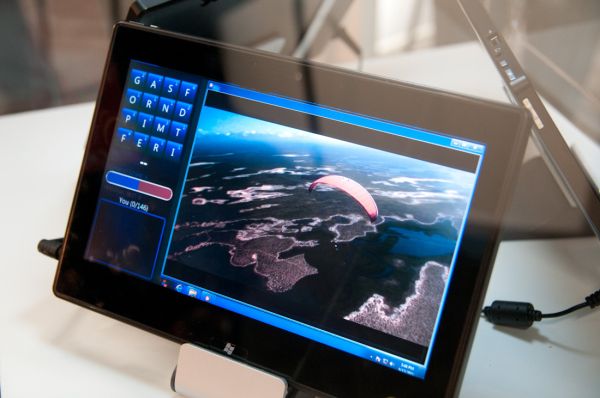
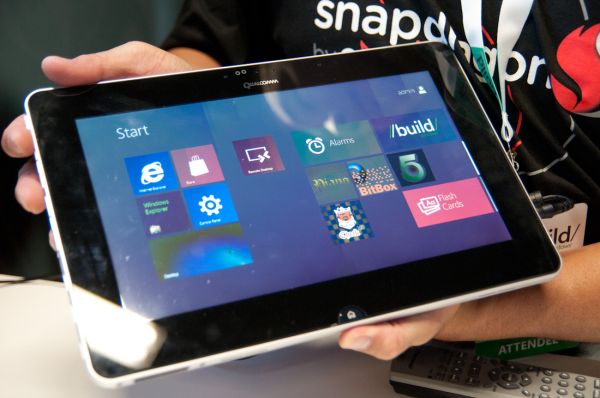
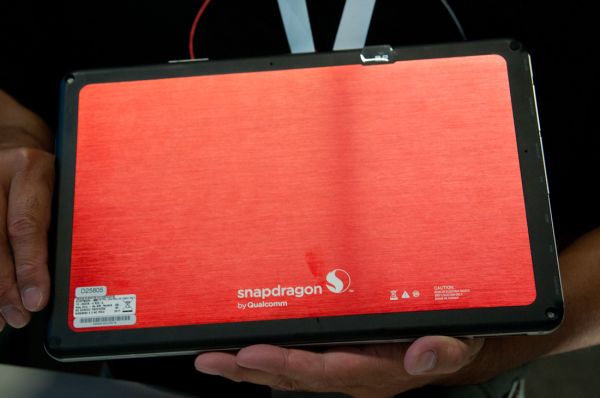
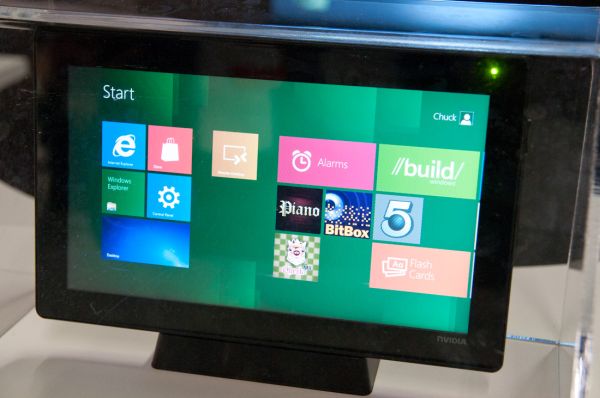
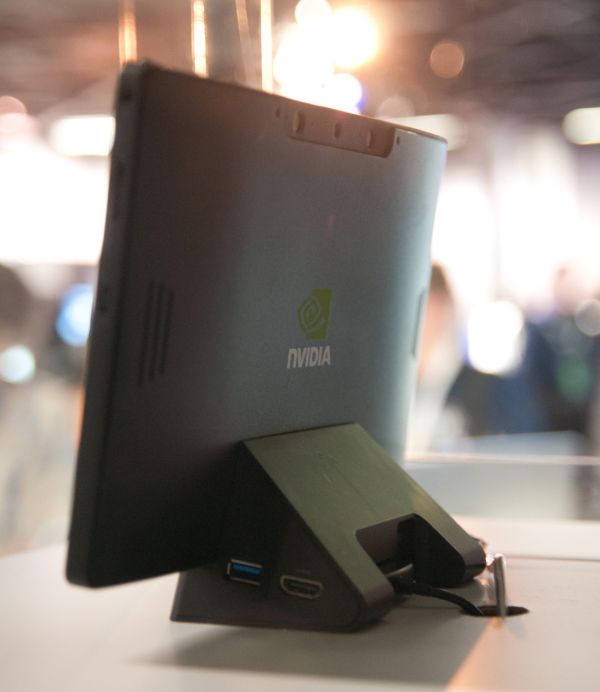
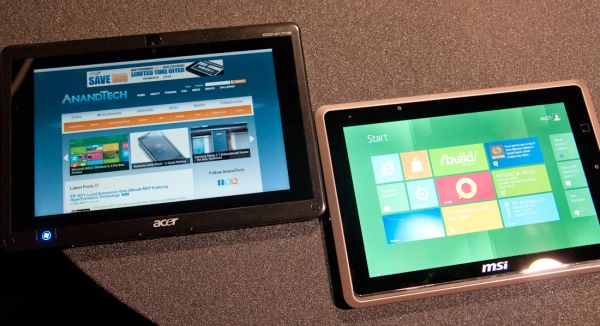
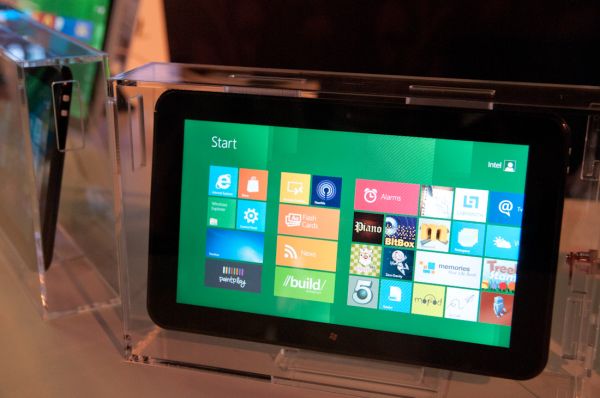














92 Comments
View All Comments
augustofretes - Friday, September 16, 2011 - link
Xorg is a piece of useless shit, there's a reason why informed people is so excited about seeing die soon.Shining Arcanine - Wednesday, September 14, 2011 - link
Why would you want to run Windows in the first place?damianrobertjones - Thursday, September 15, 2011 - link
...Because it's the best operating system in the world with the most applications and games available TODAY.Zingam - Thursday, September 15, 2011 - link
Then buy yourself a real laptop!!!What most of you demand is that your basic automobiles have wings and can fly like helicopters!
MS were always good at making even the fastest CPUs feel like from 10 years ago!
LifeByTheHorns - Thursday, September 15, 2011 - link
You do realize that the tablet version of Windows 8 won't run PC apps?http://informationweek.com/news/windows/operatings...
Fritzr - Sunday, September 18, 2011 - link
Windows on ARM will not support legacy x86 in the beginning. Windows on ARM *will* support Windows programs compiled for ARM. This includes desktop programs intended for ARM based netbooks/laptops and similar ARM based "complete" computers.There is nothing stopping the creation of an x86 translation layer that will allow x86 code to be executed on an ARM CPU. There will be a performance hit, but instruction set execution layers have been used in the past for various purposes. These are not emulators, they function as minimal interpreters executing the native code equivalent of the instruction used.
For programs and apps intended for Win8, it would be poor planning to target one ISA while ignoring the other. The devs who want to maximize income will compile binaries for all ISAs supported by the version of Windows they are targeting.
designerfx - Wednesday, September 14, 2011 - link
okay, let's see:nobody wants to trust windows with ANYTHING.
Running windows on a tablet sounds nice until you realize that absolutely zero applications of the kind people *need* to run are not going to work right in tablets.
We're back to the problem of windows itself: it all relies on the third party to make things work right.
Windows is going to run SQL properly? Adobe CS properly? Quickbooks properly? Sure it will! Just not on a tablet.
Android has not been the first, it has been the leader, due to execution. That is entirely different from iOS.
jvillaro - Thursday, September 15, 2011 - link
ok... what?Your post didn't make any kind of sense
damianrobertjones - Thursday, September 15, 2011 - link
I'm sorry but i don't think that you realise machines like the Asus EP121 with it's core i5 cpu exist... or the whole load of convertible tablets....steven75 - Thursday, September 15, 2011 - link
Yes, and how are those selling right now? They haven't sold in meaningful numbers since Tablet PC came out in 2002.Ask yourself "why is that?" What's the difference between Windows 8 in 2013 vs Tablet PC of 2002?